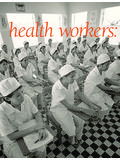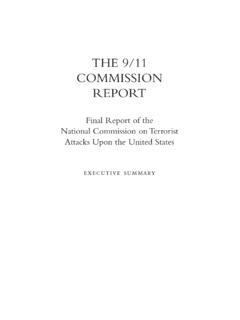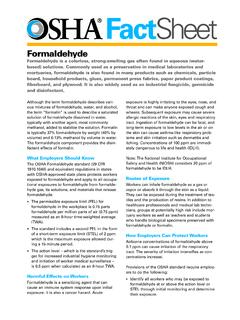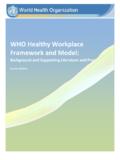Transcription of A century of change: the U.S. labor force, 1950-2050
1 Monthly labor ReviewMay 200215 labor Force Change, 1950 2050 The history of the labor forceis a story of dramatic change. The ripplingeffects of the massive demographicchanges that occurred within the populationover the latter part of the 20th century will createfurther changes in the first half of the 21st cen-tury. The labor force the number of peopleworking or looking for work is a dynamic con-cept that demonstrates the net impact of all de-mographic, social, political, and historical forcesaffecting a population. The growth of the laborforce is one of the main ingredients of economicgrowth and article profiles and projects laborforce trends for a period of 100 years, from 1950to 2050, on a decennial basis.
2 Changes in bothgrowth rates of the population and labor forceparticipation rates have created a steadily grow-ing labor force that, compared with 1950, is todayolder, more diversified, and increasingly made upof women. The same forces that have influencedthe size and composition of the labor forceover the past 50 years are expected to shape thefuture of the workforce as well. Some of the keyfindings emanating from the research uponwhich the article is based are as follows: Slowdown in growth of the high growth rate of the civilianlabor force1 in the last 50 years will be re-placed by much lower growth rates in thenext 50 years. The civilian labor force was 62million in 1950 and grew to 141 million in2000, an increase of nearly 79 million, or anannual growth rate of percent per year,between 1950 and 2000.
3 It is projected thatthe labor force will reach 192 million in 2050,Mitra ToossiWith slower growth, aging, and increasing diversity,the profile of the labor force is undergoinga gradual, but significant, changeA century of change: the labor force, 1950 2050an increase of 51 million, or a growth rate percent annually, between 2000 and 2050.(See table 1.) Changes in gender structure of the laborforce. Women in the labor force increasedtheir numbers at an extremely rapid pace inthe past 50 years. It is anticipated that theirlabor force growth will slow markedly in thenext 50 years. The factor most responsiblefor the earlier high growth rate was the rapidincrease in the labor force participation rateof women, which stood at 34 percent in 1950and increased to 60 percent by 2000.
4 Thenumber of women in the labor force rose from18 million in 1950 to 66 million in 2000, an an-nual growth rate of percent. The share ofwomen in the labor force grew from 30 percentin 1950 to almost 47 percent in 2000, and thenumber of working women is projected to reach92 million by 2050 on the basis of an annualgrowth rate of percent. That same year,women s share of the workforce is expected tobe nearly 48 percent. Changes in the age structure of the the aging of the baby-boomgeneration, the older age cohorts are ex-pected to make up a larger proportion of thelabor force in the next two decades. The 55-and-older age group, which made up 13 per-cent of the labor force in 2000, is projected toincrease to 20 percent by 2020.
5 It is antici-pated that, by 2050, the group will make up19 percent of the labor force. Changes in the racial and ethnic composi-tion of the labor force. The labor force isexpected to become more diverse. With higherMitra Toossi is aneconomist in theOffice of occupa -tional statistics andEmploymentProjections, bureau ofLabor statistics . labor ReviewMay 2002 labor Force Change, 1950 2050population growth and increasing participation rates, theshare of minorities in the workforce is projected to ex-pand substantially. The share of white non-Hispanics isanticipated to decrease from 73 percent in 2000 to 53 per-cent in 2050. Over the same period, Hispanics are expectedto more than double their share, from 11 percent in 2000 to24 percent of the labor force in 2050.
6 Blacks also are ex-pected to increase their share, from 12 percent in 2000 to14 percent in 2050. Asians, the fastest-growing group inthe labor force, are projected to increase their share from5 percent to 11 percent between 2000 and bureau of labor statistics (BLS, the bureau ) publishesmedium-term, or 10-year, labor force projections every 2 latest ones covered the 2000 10 The projectionspresented in this article provide a longer term perspective onthe labor force by looking 50 years ahead. As in the decade-long projection,3 the projected labor force is a product of twofactors: the size and growth of the population by age, sex,race, and ethnicity and the future trend of labor force partici-pation rates for various age, sex, race, and ethnicity Current Population Survey (CPS)4 is the source of his-torical data on the civilian noninstitutional population and thelabor force.
7 The population projections and the CPS are basedon estimates of births, deaths, and net immigration since themost recent decennial census. The estimates are benchmarkedto the census results. Because population projections basedon the 2000 census are not yet available, the Census bureau spopulation projections used in this article still reflect the labor force participation rates for 136 differentgroups, including both genders, 17 age groups, and 4 raceand ethnicity groups, are estimated on the basis of the laborforce participation behavior of each group in the past. (Seebox.) By applying the projected labor force participation ratesof each group to the projected population of that group, thesize of the labor force is estimated, both for detailed catego-ries and for the economy as a growth and the changes in participation ratesare the main determinants of labor force growth.
8 Table 2 pre-sents the growth rates of the civilian noninstitutional popula-tion,6 the labor force participation rate,7 and the civilian laborforce during the 100 years examined. As the rate of change inlabor force participation decreases, more of the growth rate ofthe labor force is accounted for by the growth rate of the 1950 60 period, population growth alone was re-sponsible for the growth of the labor force. During the 1960 70 period, population growth contributed about 94 percent ofthe growth in the labor force. In the 1970 80 period, when thelabor force participation of women underwent rapid growth,76 percent of the labor force growth was the result of popula-tion growth, and the rest was related to the growth of partici-pation rates, mainly of From 2000 to 2050, with theexpected overall decline in the participation rate, participationgrowth is projected to exert even less influence, and thegrowth of the labor force will likely be due mostly to the im-pact of population what follows.
9 The analysis begins with a discussion ofthe major factors that have affected the trend of the laborforce in the past 50 years and their implications for futurelabor force change: (1) different birth patterns in the during the previous 50 years; (2) the extremelyrapid growth in the participation rate of women; and (3) thegrowing racial and ethnic diversity of the labor force. Thenthe results of the long-term labor force projection are pre-Civilian labor force by sex, age, race, and Hispanic origin, 1950, 2000, and projected, 2050[Numbers in thousands]Level (in thousands)Change Percent changePercent distribution1950200020501950 20002000 501950 20002000 501950200020501950 20002000 50 Total, 16 years and older.
10 62,208140,863191,82578,65550, ..43,81975,247100,28031,42825, ,38965,61691,54547,22725, to 24 ..11,52222,71531,31711,1938, to 54 ..40,01799,974124,44359,95724, and older ..10,66918,17536,0657,50617, 117,574143, , 16,60327, , and 6,68720, , 15,36845, , than Hispanic origin .. 125,495146, , 102,963102, (457) . growthrate (percent) 1 The Asian and other group includes (1) Asians and Pacific Islandersand (2) American Indians and Alaska Natives. The historical data arederived by subtracting black and white from the total; projections aremade directly, not by subtraction. NOTE: Dash indicates data not labor ReviewMay 200217sented.


















